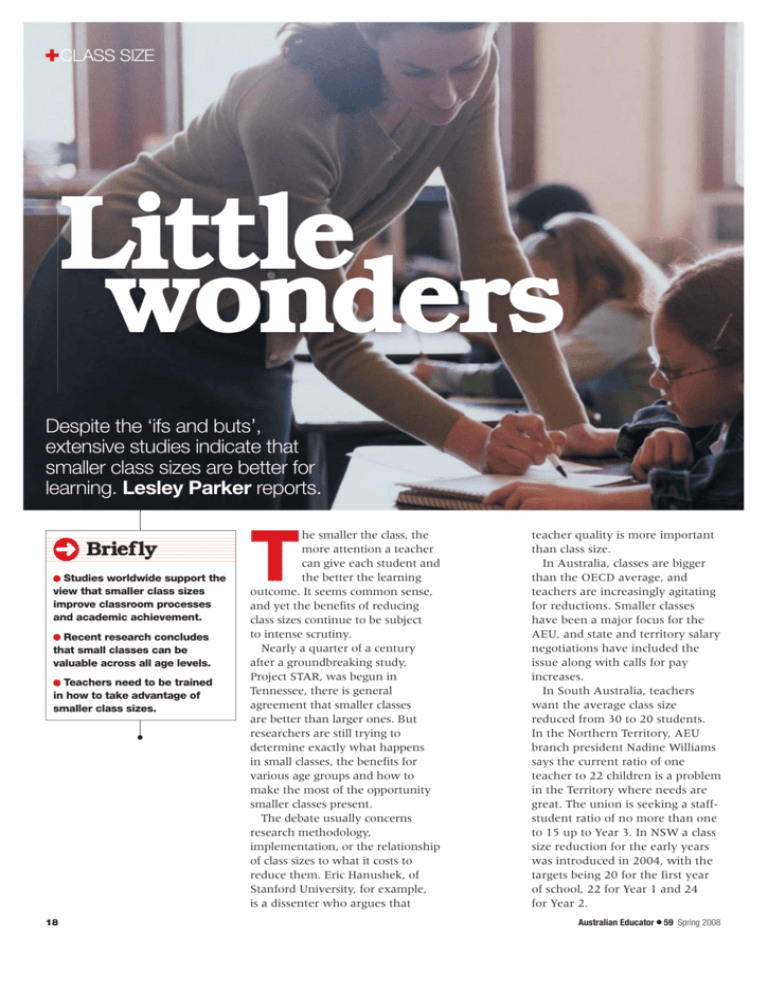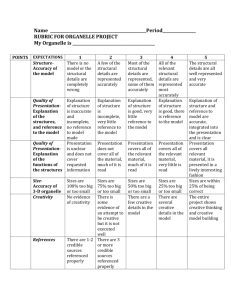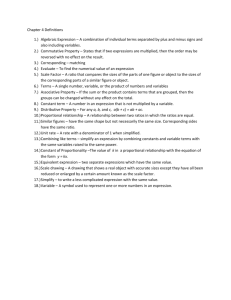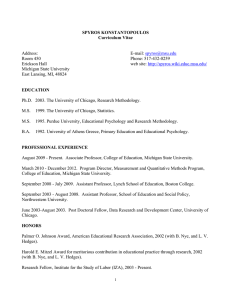'ifs and buts', extensive studies indicate that smaller class sizes are
advertisement

CLASS SIZE Little wonders Despite the ‘ifs and buts’, extensive studies indicate that smaller class sizes are better for learning. Lesley Parker reports. Briefly Studies worldwide support the view that smaller class sizes improve classroom processes and academic achievement. Recent research concludes that small classes can be valuable across all age levels. Teachers need to be trained in how to take advantage of smaller class sizes. 18 T he smaller the class, the more attention a teacher can give each student and the better the learning outcome. It seems common sense, and yet the benefits of reducing class sizes continue to be subject to intense scrutiny. Nearly a quarter of a century after a groundbreaking study, Project STAR, was begun in Tennessee, there is general agreement that smaller classes are better than larger ones. But researchers are still trying to determine exactly what happens in small classes, the benefits for various age groups and how to make the most of the opportunity smaller classes present. The debate usually concerns research methodology, implementation, or the relationship of class sizes to what it costs to reduce them. Eric Hanushek, of Stanford University, for example, is a dissenter who argues that teacher quality is more important than class size. In Australia, classes are bigger than the OECD average, and teachers are increasingly agitating for reductions. Smaller classes have been a major focus for the AEU, and state and territory salary negotiations have included the issue along with calls for pay increases. In South Australia, teachers want the average class size reduced from 30 to 20 students. In the Northern Territory, AEU branch president Nadine Williams says the current ratio of one teacher to 22 children is a problem in the Territory where needs are great. The union is seeking a staffstudent ratio of no more than one to 15 up to Year 3. In NSW a class size reduction for the early years was introduced in 2004, with the targets being 20 for the first year of school, 22 for Year 1 and 24 for Year 2. Australian Educator 59 Spring 2008 PHOTOLIBRARY.COM Class size was among beginning teachers’ top four concerns… A top concern In an era of teacher shortages, smaller classes have an impact on attraction and retention. Class size was among the top four concerns in the AEU’s recent annual survey of beginning teachers. It came in just behind workload, pay and (closely related) behaviour management for beginning teachers—half of whom didn’t expect to be working in the public system in 10 years’ time. In the Australian Council for Education Research survey Staff in Australia’s Schools, 69 per cent of primary school teachers and 61 per cent of secondary teachers “strongly agreed” that smaller classes would help retain teachers in the profession, making it the most prevalent measure in that respect. “For parents and the public in general, investing in our public schools to lower class sizes and deliver more individual attention to students remains the top Australian Educator 59 Spring 2008 priority,” AEU federal president Angelo Gavrielatos told the national conference in January in reference to the union’s polling. More engagement Internationally, academic research continues to support the notion that smaller class sizes can only benefit children. The University of London’s Institute of Education is still reviewing a study of the effects of class size on classroom processes such as pupil engagement. In an earlier study in which the institute tracked 10,000 pupils in more than 300 primary schools, it found “a clear effect of class size differences on children’s academic attainment over the first year” in both literacy and mathematics. However, the class size and pupil adult ratio project also found that the effects “wash out” in subsequent years, especially if children move to a larger class. The institute’s latest study, reported in March, was widened to include secondary schools, making it one of the first in the world to consider the impact of smaller class sizes on older children. In monitoring momentby-moment behaviour in classrooms of differing sizes, the researchers observed nearly 700 children in 27 primary and 22 secondary schools selected at random. Class size was defined as the number of children actually in the room at the time rather than the number on the register. Pairs of observers watched eight children in each class, noting their behaviour every 20 seconds. The children had been classified as low, medium and high attainers. As class sizes became smaller, there were more times when pupils were the focus of a teacher’s attention, and more times when they were engaged in interacting with teachers. “This effect was found for all groups at both primary and secondary levels,” the study paper says. In larger classes, pupils’ classroom engagement decreased particularly for pupils already attaining at lower levels. This meant that teachers in larger classes spent more time dealing with negative behaviour by low and medium-attainment pupils. “It is suggested that small classes can be a valuable educational initiative right through school, but could be particularly targeted at lower-attaining pupils at secondary level,” the researchers conclude in the paper, delivered at the American Educational Research Association’s annual meeting this year. Previous research has shown that teachers don’t always adapt their approach to take advantage of 19 small classes, Peter Blatchford, who led the UK institute’s studies, told Australian Educator. They continue to focus on whole-of-class teaching rather than providing more individual attention or teaching to small groups. It follows that this may be one reason why some studies of class size haven’t found obvious effects on pupil achievement. Blatchford, a world authority on class size, says individualisation shouldn’t be at the expense of independent or group learning, which can work in both small and larger classes. “One solution [is] to make more strategic use of …teachers in larger classes spent more time dealing with negative behaviour… [another] context for pupils learning together, with a deliberate attempt to minimise the teacher’s input, where pupils have more control over the learning that takes place.” He says professional development should be used to help teachers harness the opportunities of small classes, and help teachers develop strategies for realising educational objectives in large classes. Achievement gap The Project STAR data has been re-analysed to investigate the effect on the gap between low and high achievers. “In my mind, [the project’s] evidence about the positive effects of small classes on student achievement is overwhelming and convincing,” says Spyros Konstantopoulos, assistant professor at the School of Education and Social Policy, Northwestern University, Illinois, who did the analysis. “What’s 20 unclear is whether class size reduction is a mechanism that will produce additional benefits for students who are at risk of school failure for example, low achievers and disadvantaged students.” In his study, published this year, he found that although smaller class sizes increased achievement on average for all types of students, it didn’t reduce the gap between low and high achievers. This shouldn’t be interpreted as meaning that lower-achieving students are better off in larger classes, Konstantopoulos told Australian Educator. “The low achievers in small classes performed better than their counterparts in regular-size classes. That is, all students benefit from small classes.” Project STAR (Tennessee’s Student Teacher Achievement Ratio), regarded as one of the most significant studies in education in the past 25 years, began in 1985 as a large-scale controlled experiment tracking thousands of students in small and large classes, some now as far as graduation. Also using project STAR data, Princeton University economist Alan Krueger found that attending small classes up to Year 3 increased the likelihood a student would seek to enter university. The effect was particularly strong for minority group and disadvantaged students. Attending small classes appeared to cut the black/white gap in the probability of taking a university entrance exam by more than half, said Krueger in a paper published in 2000. Health policy researchers Peter Muennig, of Columbia University, and Steven Woolf, of Virginia Commonwealth University, say reducing class sizes “may be more cost-effective than most public health and medical interventions”. In a paper published late last year, they estimate the costs of reducing class sizes from kindergarten through Year 3. Then using long-term results from Project STAR that indicate small classes lead to higher graduation rates, they model the effects on a hypothetical group of five-yearolds through to age 65. Like other researchers, they note the question mark over whether the results in Tennessee are specific to Tennessee, or whether the STAR outcome would automatically be replicated elsewhere. They conclude that students from small classes are likely to live longer and earn more. Add the effects of welfare savings and lower crime rates, they say, and a class-size initiative is likely to save governments money in the long run. ● Lesley Parker is a freelance writer. Resources Project STAR: www.heros-inc. org/classsizeresearch.htm University of London research: www.classsizeresearch.org.uk ‘Do Small Classes Reduce the Achievement Gap?’ by Spyros Konstantopoulos: www.journals.uchicago.edu/doi/ pdf/10.1086/528972 Princeton University research: www.heros-inc.org/starcollege.pdf Peter Muennig and Steven Woolf’s research: http://redorbit.com/news/ education/1137380/health_and_ economic_benefits_of_reducing_the_ number_of_students/index.html Other reports and research: www.reduceclasssizenow.org/ structuredAbstracts.htm ‘The Class Size Debate’, edited by Lawrence Mishel and Richard Rothstein: www.epinet.org Australian Educator 59 Spring 2008







